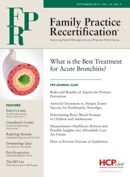Publication
Article
Family Practice Recertification
The Pelvic Examination: To Do or Not to Do...?
Author(s):
"Beauty is in the eyes of the beholder" and "seeing the same glass as being half-empty or half-full" are two commonly cited adages and nowhere is their meaning more evident than in the ongoing debate of whether a pelvic examination should be part of the routine check-up of a female patient.

Martin Quan, MD
Editor-in-Chief
“Beauty is in the eyes of the beholder” and “seeing the same glass as being half-empty or half-full” are two commonly cited adages and nowhere is their meaning more evident than in the ongoing debate of whether a pelvic examination should be part of the routine check-up of a female patient.
Taking a stand against it is a recently released clinical guideline from the American College of Physicians which was published in the July 1, 2014 issue of the Annals of Internal Medicine. The opposite view is supported by the American College of Obstetrics and Gynecology (ACOG) which soon thereafter released a statement reaffirming its support of including the pelvic examination as a routine component of the annual well-woman visit.
The ACP guideline firmly recommends against performing a screening bimanual pelvic examination in asymptomatic, non-pregnant, adult women. The ACP based its recommendations following a systematic review of the medical literature from the past 50 years. Their analysis found no evidence of benefit with regards to cancer screening (including ovarian cancer), detection of significant benign conditions, or reduction of morbidity or mortality.
Moreover, the ACP analysis also cited potential downsides resulting from over-diagnosis and over-treatment as well as patient pain, discomfort, and emotional distress stemming from the examination. This was noted to be especially true among women with a history of domestic violence.
From the perspective of ACP, this lack of benefit was compounded by the cost directly and indirectly associated with the annual pelvic examination. According to their research, an estimated $2.6 billion is spent each year on preventative gynecologic examinations, lab tests and radiologic services stemming from findings on the examination.
In their public position, ACOG argued vigorously against the ACP position, making the argument “the absence of evidence is not necessarily evidence of absence”. While acknowledging the lack of scientific evidence supporting an annual pelvic exam for an asymptomatic, low-risk patient, ACOG opined the value of pelvic exams was supported by the clinical experiences of gynecologists caring for their patients.
Furthermore, ACOG also cited the role the examination plays in uncovering sexual dysfunction and urinary incontinence, which may be undisclosed or silently accepted by the patient, as well as the indirect benefits it provides as a segue to contraceptive counseling as well as preventive measures such as screening and health risk factors identification and management. ACOG continues to advocate for the inclusion of the pelvic examination when conducting the well-women visit, with the final decision on whether it is performed being made the woman in consultation with her doctor, on the basis of her own needs and priorities
How to reconcile the two opposing positions? Suffice it to say the value and benefit of any routine examination rests both with characteristics of the patient as well as the skill and experience of the clinician. For internists, a significant proportion likely have not had the training or experiences required to maximally realize the upsides that might be derived from performing a pelvic examination.
However, The downsides of “going through the motions” of doing such an examination might very well exceed any benefit in female patients who makes an appointment for a routine comprehensive physical examination (CPE). Conversely, gynecologists are likely to be better trained and grounded in detecting and addressing issues referable to the reproductive tract unique to women. As a result, routine performance of a pelvic examination may be well worth the effort in patients so inclined to schedule a “female wellness exam” with their gynecologist.
Where does that leave the family physician? For those of you who perform the pelvic examination solely because it is part of a CPE and who are, at best, a passive examiner of the female genital tract, one could easily argue it would be best to adhere to the ACP position. However, for those possessing the knowledge and skill set to actively take a history and evaluate the female patient regarding gynecologic issues, performance of the pelvic examination will likely continue to be a useful element of the comprehensive physical examination of a female patient.
Martin Quan, MD
Editor-in-Chief
Martin Quan, MD, is Professor of Clinical Family Medicine and Director of the Office of Continuing Medical Education at the David Geffen School of Medicine at UCLA. He is also a member of the Education Advisory Board and consultant to the Committee on Continued Professional Development of the California Academy of Family Physicians and a member of the Kidney Learning System Advisory Board of the National Kidney Foundation. In the past, Quan has served as Program Director of the UCLA Family Practice Residency Program, Co-Director of the UCLA Pre-Doctoral Program in Family Practice, Editor-in-Chief of Clinical Cornerstone, and Vice Chair of the Residency Review Committee in Family Practice for the Accreditation Council for Graduate Medical Education (ACGME).






